IRT (infrared thermography) had widespread use as a military technology in the 1970’s but found itself in commercial use soon after. Today the technology is employed in various fields including medicine, surveillance, engineering, and building diagnostics, which includes home inspections.
For home inspectors, knowledge in training of IRT can help diagnose defects that may not have been apparent in a routine inspection, reveal further defects and underlying causes, and can make the job safer.
Here is a list of some home inspection applications for IRT:
- Determine if there are any air-leaks or abnormalities in heat flowing out of a building
- Determine if insulation if lacking or deficient
- Determine if there is any moisture intrusion with insulation or other systems (when used with a moisture meter)
- Determine if electrical systems are overloaded or overheating
- Determine if there are leaks or defects with the roof
- Determine defects with the HVAC system
How Does It Work For Energy Audit Inspections?
For energy-audit inspections, the camera reads infrared radiation in order to express heat differences and temperature signatures. The camera sees light that is within the heat spectrum that exists just beyond the spectrum that can be seen with the naked eye. Differing heat signatures are displayed in the camera’s viewfinder as a gradient color scheme, with hotter areas displayed as brighter colors, and cooler areas as darker colors. An inspector can view this information on the camera in order to make observations and find defects. By viewing the hottest and coldest areas, inspectors can collect valuable data about the building envelope. Images taken with the IR camera are then included alongside digital photos of the same problem area in the inspection report.
Using IRT To Locate Moisture Problems
Infrared thermography is non-invasive and will not disturb or affect the target area. Detecting moisture intrusion problems is an excellent application for thermal imaging or infrared (IR) cameras. Moisture intrusion may be identified through basic visual inspection if it has lead to obvious defects, such as staining or mold growth. By the time visible evidence has presented itself, however, significant damage may have already been done. In many cases, moisture or water intrusion may have been developing for a while before obvious signs become apparent.
By employing thermal imaging and a moisture meter, inspectors can locate moisture issues before they become large problems and lead to serious damage, as well as gather details in cases where moisture intrusion has already become obvious. The IR camera sees the apparent temperature difference between wet spots and building materials. Water intrusion and excessive moisture within walls, under floors, and above ceilings will show up in the thermal image. Water intrusion implies that the house has been compromised somewhere, perhaps through the roof, in the basement, or as the result of a mechanical or plumbing leak.
It’s important to remember that thermal imaging should be used in conjunction with a moisture meter to identify moisture intrusion problems. Once a potential trouble spot is located through thermal imaging, the problem can be verified with the moisture meter.
The issue can then be documented by saving an infrared image alongside a digital photo to include with a description of the problem in the inspection report.
Thermal imaging can be employed effectively to find moisture:
- behind the refrigerator, and under the cooking range, as well as around vents and exhaust fans;
- in the kitchen around the sink
- under the dishwasher
- in bathrooms around plumbing fixtures and outlets, shower and bathtub enclosures, fixtures and vents, the toilet and bidet, and windows;
- the HVAC system;
- the water heater;
- in the attic, including roof pass-throughs and penetrations, connecting walls, vents and fans, and recessed lights;
- in the basement, including walls, ductwork and crawlspaces;
- in the laundry area around the washer and dryer hookups, drip pans and exhaust vents, as well as utility sinks.
Using IRT For Electrical Components
Since components in electrical systems almost always overheat before they fail, problem areas are more easily and safely found when viewed through an IR camera.
Infrared imaging allows apparent temperatures to be seen as gradient colors, with hotter spots displayed as brighter colors, and cooler (and wetter) spots displayed as darker colors. When a malfunctioning electrical component or connection is generating more heat than it should be, its apparent temperature will make it stand out right away when viewed through thermal imaging.
What kinds of electrical problems can be detected?
Thermal imaging can detect electrical issues that include:
- excessively hot or loose connections;
- overloaded wiring;
- overloaded circuits;
- overloaded transformers;
- overloaded motors;
- arcing; and
- excessive harmonics.Infrared cameras are popular for finding moisture intrusion problems because of the many advantages they provide over conventional methods.
Using infrared cameras for electrical inspections is safe and quick, and is a great way to document problems that convey useful and easy-to-understand details for property owners.
Why Use IRT To Inspect Roofing?
Employing IR cameras for home and commercial roof inspections is on the rise, with millions of square feet now being inspected using this technology every year.
Replacing damaged roofs can cost as much as $8 to $10 per square foot, and billions of dollars are lost every year because of premature roof failure.
The main causes of premature roof failure and high maintenance costs are moisture intrusion and undetected wet insulation inside the roofing system. Because thermal imaging makes apparent temperature differences viewable, it is excellent at finding moisture and then documenting problem areas during roof inspections. The roof absorbs heat during the day and releases it when the temperature falls later. Wet areas release heat slower than dry areas. Because of this, the wet and dry areas are readily viewable in a thermal image, which displays apparent temperature differences as gradient colors.
Advantages of Using IR Imaging for Roofs
Thermal imaging is non-invasive and allows inspectors to scan large areas very quickly. More traditional methods require a grid-type contact search, which is very time-consuming for inspectors who choose to walk a roof for inspections. Core sampling and other invasive testing are destructive and beyond InterNACHI’s Standards of Practice. Using an infrared camera to locate areas of moisture intrusion and wet insulation is quick, accurate and inexpensive compared to other methods. Since IR imaging allows problem areas to be located before severe symptoms appear, significant damage can be avoided by catching and addressing issues as they develop. Thermal imaging can also be performed from an elevated vantage point, allowing an even greater area to be examined at once, and eliminating the need to lug equipment up and down various roof elevations.
Here‘s a list of advantages of using an IR camera for roof inspections:
- It’s fast and accurate.
- It can identify small problem areas before they become larger.
- It provides a thorough assessment of compromised and damaged areas.
- IR equipment is lightweight and portable.
- It provides visual documentation of problems.
- It is non-invasive.
- It can be used for inspections that are conducted as part of regular home maintenance.
Consumers can benefit greatly from utilizing IR technology for roof inspections, potentially saving the cost of expensive repairs.
How Do I Order an IRT Inspection?
You will find Infrared thermography listed on our menu of services that we offer. By choosing the option of IRT, you will add to your peace of mind by seeing documentation of measurable readings for potential problems before they surprise you.


